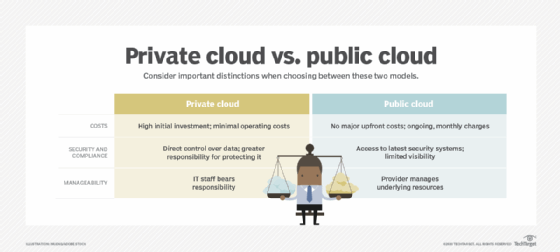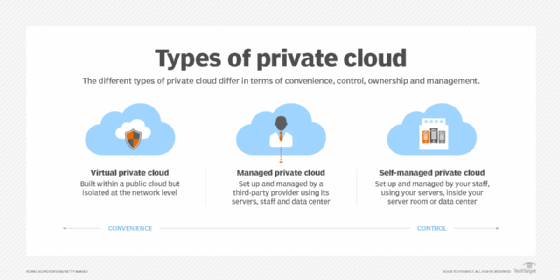
Getty Images/iStockphoto
10 common issues when creating a private cloud
Organizations that want to create a private cloud must prepare for a multitude of issues, including security, compliance, staff expertise and cost.
Private clouds appeal to businesses that need the flexibility and self-service found in a public cloud, with the control and transparency found in on-premises infrastructures. However, implementing and managing a private cloud can be a challenging endeavor fraught with complex problems.
Gain a better understanding of how private and public clouds differ, as well as the most common private environment problems to avoid deployment and management headaches.
Private vs. public clouds
Private and public clouds are two models of cloud computing intended to deliver different sets of benefits to a business:
- A public cloud, such as AWS, Microsoft Azure or Google Cloud, is designed for extremely high scalability, offering a broad set of services and resources across a global footprint. Public clouds operate using multi-tenant architectures, where resources and services are shared, and business data is primarily retained remotely in the public cloud.
- A private cloud is designed for high levels of control and oversight, which enable the business to provide cloud self-service and autonomy, while enforcing direct control over the infrastructure and data that constitute the private cloud. But this also limits the scope, scalability and services of most private clouds.
Consequently, public and private clouds are not mutually exclusive and can be used simultaneously to deliver different business benefits. Public and private clouds can also connect to provide a hybrid cloud, ideally bringing the benefits and capabilities of both cloud paradigms to the business.

Private cloud deployment issues
After defining what a private cloud is, let's discuss the 10 most common issues to consider when establishing a private cloud.
1. Undefined objectives
Tech envy is the bane of modern businesses. Don't implement costly technology, like a private cloud, just because it's in the media or pursued by a competitor. Understand the needs or justifications for a private cloud, and assess the value of such a project with a cost-benefit analysis. Users need to understand the following:
- Why a private cloud is needed.
- What it needs to do for the business.
- How it should align with business goals.
2. Infrastructure costs
Private clouds rely on on-premises infrastructure, so a business needs to provision -- or build -- on-premises infrastructure that is dedicated to private cloud use. This demands significant capital investment, which can initially cost more than the pay-as-you-go model of public clouds. Understand the hardware, software, talent and time investments needed to build a private cloud, and budget accordingly.
Also, the different types of private cloud come with different costs. Note the following when planning a private cloud deployment:
- Self-managed private cloud. Also known as an on-premises cloud, an organization creates and manages this cloud autonomously. The facility that houses the infrastructure is either an on-premises server room, a company-owned data center or a colocation center on rented rack space.
- Managed private cloud. A third-party provider manages the cloud infrastructure, which is reserved for the use of one organization.
- Virtual private cloud. A VPC is the division of a service provider's public, multi-tenant cloud architecture to support private cloud computing.

3. Poor expertise
Private clouds can be complex to design, build, manage and maintain -- especially supporting services and frameworks, such as enterprise applications, software services, automation and orchestration. This demands extensive expertise from IT staff, which might not be present within the current available personnel. These skills could include the following:
- Infrastructure management related to on-premises hardware and virtualization technologies.
- Security management focused on private cloud needs.
- Advanced networking expertise to handle complex configurations from strict security needs.
A private cloud project might require new staff, or current staff might need extensive new training and education.
4. Limitations
Consider the pressing limitations for a private cloud. IT infrastructure is finite, so private clouds rarely approach the capabilities of modern public clouds. There is only so much money, time and talent available to a modern business.
For example, a private cloud rarely offers the capacity, scope of services or level of scalability found in the public cloud. Public cloud has far more experienced staff and a global data center footprint for scale. For this reason, some businesses choose a hybrid cloud approach.
5. Compliance and governance requirements
Consider how creating a private cloud impacts vital compliance and governance issues. Depending on the industry and business, there may be strict compliance requirements to protect personal data, such as in healthcare with HIPPA or a company that does business with the European Union with GDPR.
Strict data privacy compliance regulations need to be reflected in user access, data storage and retention throughout the private cloud. Similarly, business governance must evolve to reflect the new capabilities and risks of a private cloud, including data access, usage, security and business continuance.
6. Resilience
Systems and devices fail, and failures within a private cloud can profoundly impact the business. Public clouds can fail over to other regions or even to other providers.
Consider the level of resilience needed to ensure system and data availability. This might include high availability architecture designs, real-time data protection and backup/restoration capabilities, and other technologies to mitigate downtime.
7. Configuration and data protection
Private cloud design should include careful consideration of security features, such as encryption, firewalls and access controls.
A large portion of security problems arise from poorly configured infrastructure and excessive (loose) permissions. Private clouds demand close consideration of hardware and software configurations, strict change management and careful behavioral monitoring. This helps to ensure that the private cloud is secure and that minimum access and privileges are provisioned to users.
8. Monitoring
Is the private cloud working and maintaining service levels the way it should? Use a suite of monitoring tools that can gather and report important performance metrics across the private cloud. Decide what the vital metrics should be, along with desired performance parameters. These metrics could include resource utilization, such as CPU, memory and storage. Also, consider how metrics should be reported and reviewed.
When private cloud designers can understand how the cloud should work, it's far easier to identify, understand and remediate issues before they escalate.
9. Continuous optimization
IT infrastructure is rarely static. Private clouds benefit from periodic reviews and upgrades to enhance vital factors, such as reliability, efficiency, capability, performance and capacity. Understand how to use monitoring and reporting to evaluate private cloud performance and set the stage for periodic upgrades and optimizations over time. Optimizations should also include careful attention to changing business goals and strategies, ensuring that the private cloud aligns with business needs.
10. Technologies
Technologies represent the "how" of a public cloud and are often the last factor to consider. As with any data center endeavor, private cloud designers should build an infrastructure using reliable and extensive systems or devices that are well suited to established goals. Technologies should fit business goals, not the reverse. Select vendors for their product reliability, compatibility and support.
Stephen J. Bigelow, senior technology editor at TechTarget, has more than 30 years of technical writing experience in the PC and technology industry.







